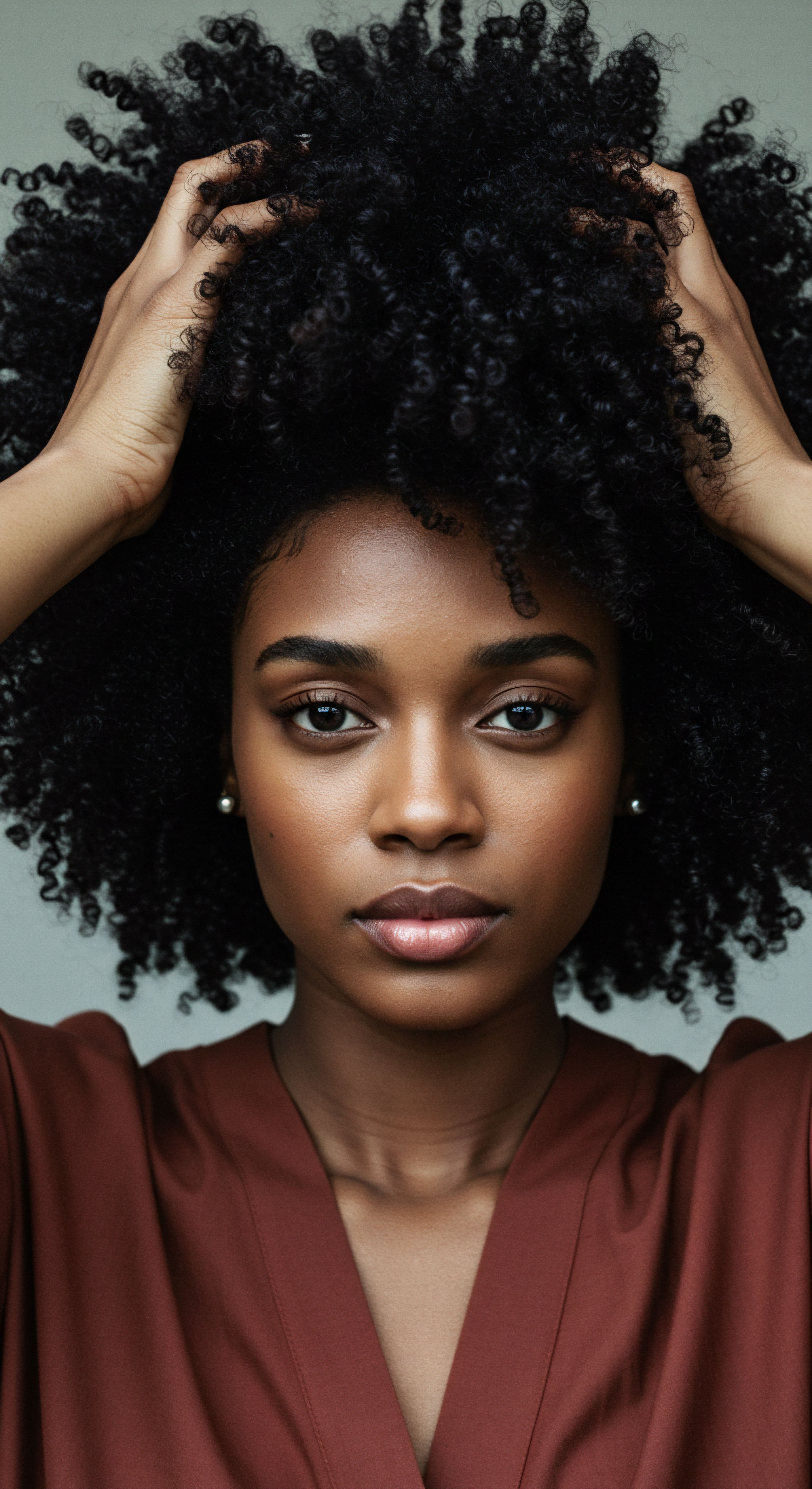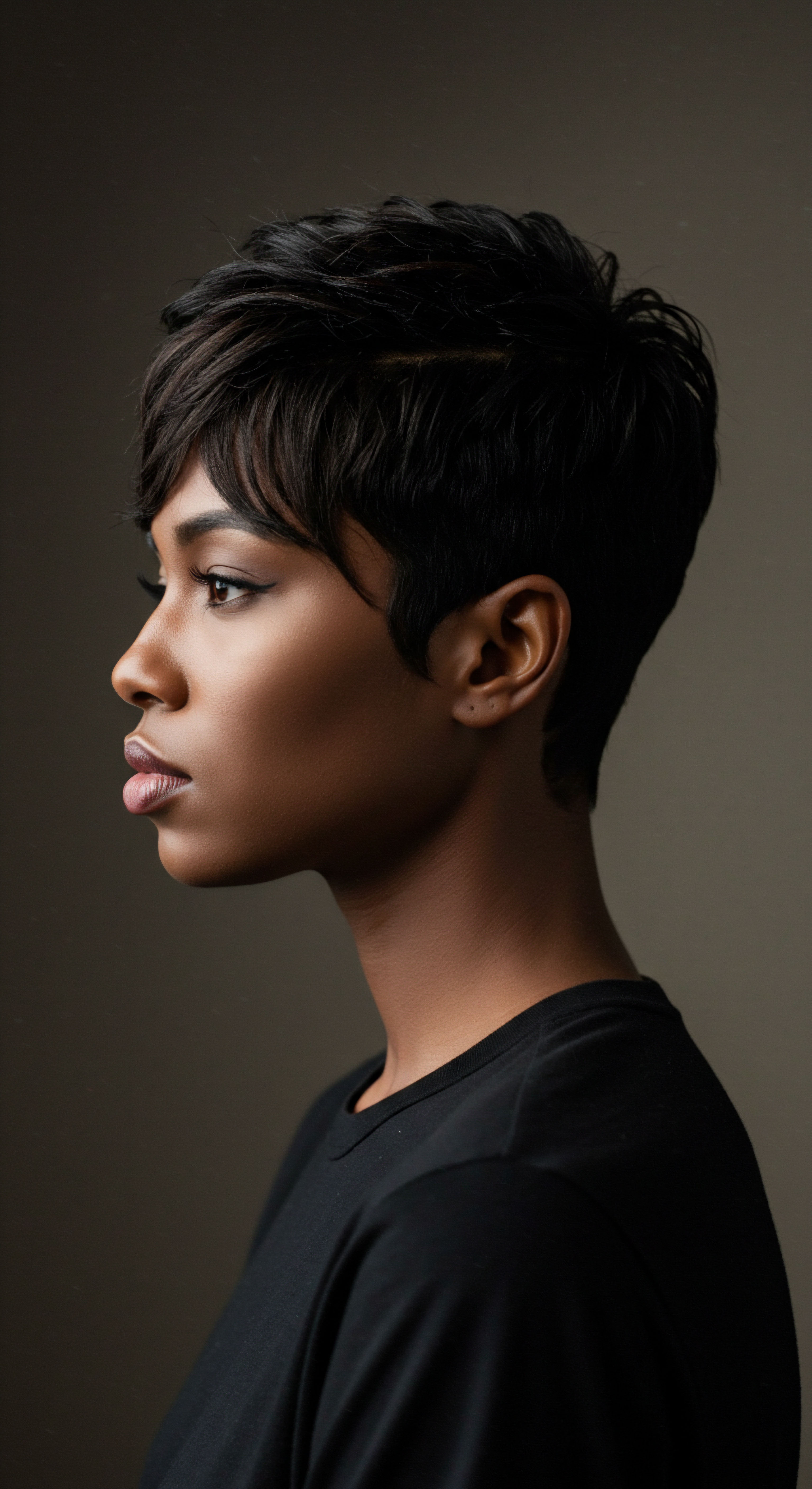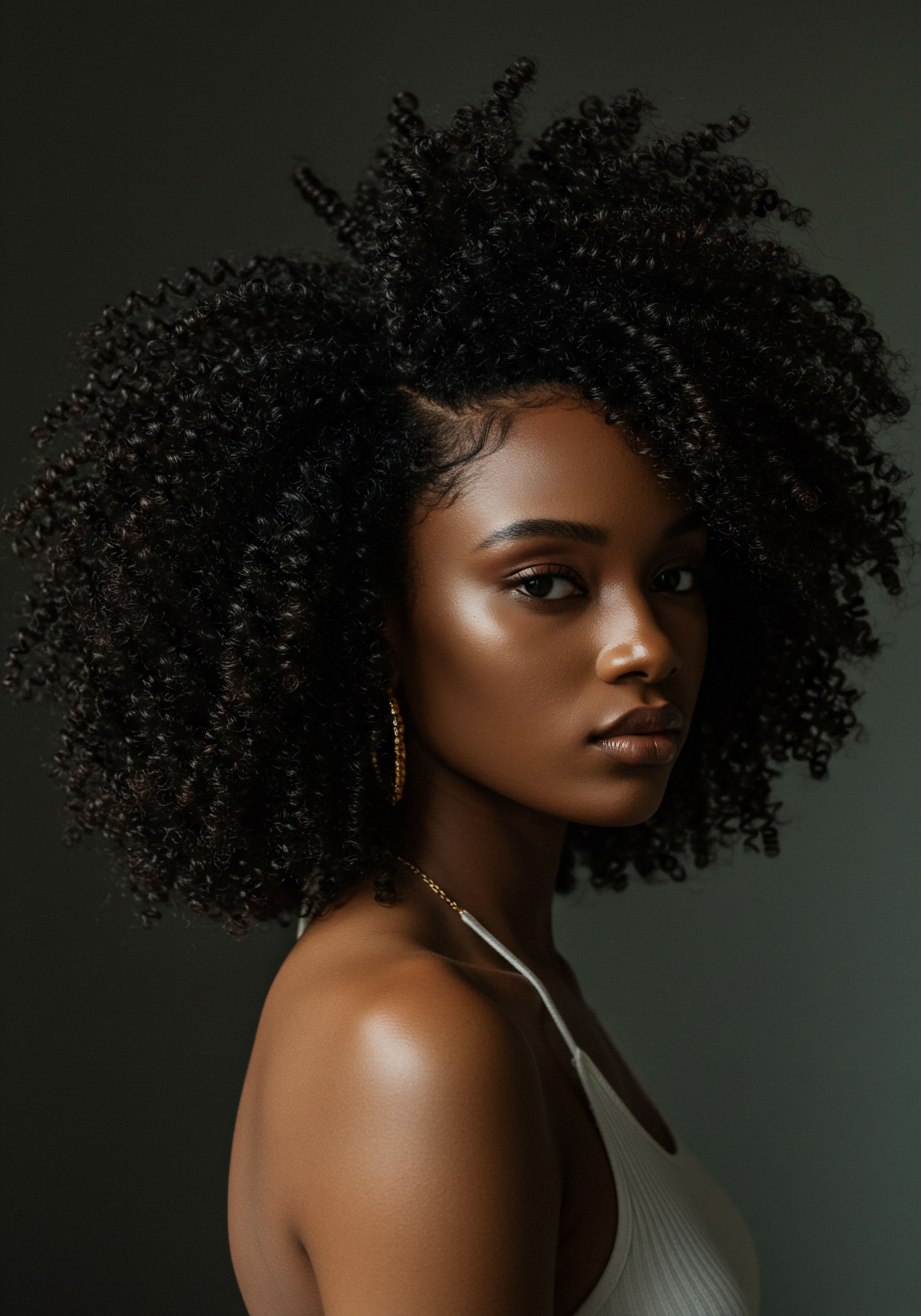
Roots
The quiet moments of rest, when the world outside softens its demands, often hold a surprising sway over the very foundation of our being, including the strands that crown our heads. For those with textured hair, this nocturnal period, far from being a simple pause, becomes a delicate dance between preservation and potential peril. We consider here how the unseen forces at play during sleep might genuinely reshape the long-term structural integrity of textured hair. It is a contemplation of the elemental, a deep breath before a deeper understanding of what our hair experiences when we are unaware.

Understanding Hair at Its Core
To truly appreciate the impact of sleep protection, one must first grasp the intrinsic makeup of a single hair strand. Hair, particularly textured hair, is a complex biological marvel. Each strand is primarily composed of Keratin, a strong fibrous protein.
This protein forms the hair shaft, which is the visible part extending from the scalp. The hair shaft itself has three main layers ❉ the cuticle, the cortex, and, in some cases, the medulla.
- Cuticle ❉ This outermost layer consists of overlapping, scale-like cells, similar to shingles on a roof. Its primary role is to shield the inner structures from external damage. When these scales lie flat, they create a smooth surface that reflects light, contributing to hair’s natural luster. For textured hair, these cuticle layers tend to be slightly raised, making them more susceptible to external forces.
- Cortex ❉ Lying beneath the cuticle, the cortex constitutes the bulk of the hair shaft, accounting for approximately 90% of its weight. This layer houses the melanin, which determines hair color, and provides hair with its strength, elasticity, and flexibility. The cortex’s health is directly linked to the integrity of the protective cuticle.
- Medulla ❉ The innermost layer, the medulla, is not present in all hair types and is typically found in thicker, coarser strands. Its exact purpose remains less clear.

How Hair Porosity Shapes Its Experience
Beyond these structural components, hair porosity stands as a key characteristic influencing how textured hair responds to its environment, including nighttime conditions. Porosity refers to hair’s capacity to absorb and retain moisture. This characteristic is heavily influenced by the condition of the cuticle layers.
Hair with low porosity features tightly packed, closed cuticle scales, making it resistant to moisture penetration but also adept at retaining it once absorbed. Conversely, high porosity hair has more open or damaged cuticle scales, allowing moisture to enter easily but also to escape just as readily, often leading to dryness and frizz. The very structure of textured hair, with its inherent coils and bends, means its cuticle layers are naturally more prone to being raised, which can lead to higher porosity in various sections of the hair shaft. This predisposition makes textured hair particularly vulnerable to environmental factors and mechanical stress, which can further lift or damage the cuticle, altering its porosity over time.
The fundamental structure of textured hair, particularly its cuticle and porosity, sets the stage for how it responds to nightly influences.

The Role of Lipids and Keratin Bonds
The resilience of hair is also deeply tied to its chemical composition, particularly the arrangement of keratin proteins and the presence of lipids. Keratin proteins are linked by various bonds, including disulfide bonds, which are crucial for hair’s strength and elasticity. Damage to these bonds can compromise the hair’s structural integrity.
Additionally, a delicate lipid layer, often referred to as the F-layer or 18-MEA layer, coats the outermost surface of the cuticle. This lipid barrier is hydrophobic, meaning it repels water, helping to maintain hair’s smoothness, reduce friction, and regulate moisture. When this lipid layer is compromised by chemical treatments, heat, or mechanical stress, the hair becomes more hydrophilic, absorbing water more readily but also losing it faster, contributing to dryness and increased vulnerability. The preservation of this lipid layer is a quiet but persistent battle for hair health, especially for textured hair which naturally experiences challenges in sebum distribution along its coiled strands.

Ritual
Stepping from the quiet understanding of hair’s core being, we now turn to the deliberate practices that shape its nightly experience. For textured hair, the hours spent in slumber are not merely a time for rest; they are a crucible where daily wear meets nightly care, where the right choices can either fortify or diminish the hair’s intrinsic resilience. How might the mindful application of sleep protection truly shield and support the long-term structural integrity of textured hair? This section invites us to consider the conscious actions that honor our hair’s delicate nature, transforming the ordinary act of sleeping into a profound ritual of preservation.

The Silent Assault of Friction
One of the primary antagonists to hair health during sleep is friction. As we shift and turn through the night, our hair rubs against pillowcases, particularly those made of rough materials like cotton. This constant mechanical agitation can have a detrimental effect on the hair’s outer cuticle layer.
For textured hair, which already has naturally raised cuticle scales, this friction is particularly damaging. The rubbing causes these scales to lift further, or even chip away, leading to increased frizz, tangles, and split ends. This surface damage then exposes the inner cortex to further environmental and mechanical stressors, accelerating overall hair degradation. The cumulative effect of nightly friction can lead to a significant loss of hair density over time, making strands weaker and more prone to breakage.
Nightly friction, especially against rough surfaces, can relentlessly abrade the delicate outer layer of textured hair.

How Do Pillowcase Materials Impact Hair Health?
The choice of pillowcase material plays a pivotal role in mitigating sleep-induced hair damage. Cotton, a common choice, is known for its rough texture and its tendency to absorb moisture. This dual action creates a harsh environment for hair, leading to both increased friction and dehydration.
Conversely, materials like silk and satin offer a smoother surface, allowing hair to glide with minimal resistance. This reduction in friction directly translates to less cuticle damage, fewer tangles, and a noticeable decrease in breakage. Furthermore, silk and satin do not absorb hair’s natural oils and applied products as readily as cotton, helping to maintain essential moisture levels throughout the night.
| Material Cotton |
| Surface Texture Rough, fibrous |
| Moisture Absorption High |
| Hair Impact Increased friction, tangles, breakage, dryness, frizz |
| Material Silk |
| Surface Texture Smooth, soft |
| Moisture Absorption Low |
| Hair Impact Reduced friction, fewer tangles, moisture retention, less frizz |
| Material Satin |
| Surface Texture Smooth (weave) |
| Moisture Absorption Low |
| Hair Impact Similar benefits to silk, cost-effective alternative |
| Material Choosing a smoother pillowcase material significantly reduces mechanical stress on hair during sleep. |

Protective Styles for Nighttime Serenity
Beyond the surface beneath the head, the manner in which textured hair is prepared for sleep holds considerable sway over its long-term health. Loose, protective styles can significantly reduce the mechanical stress experienced during tossing and turning.
Tight hairstyles or harsh hair ties can pull and damage hair, particularly at the roots and along the length of the strand. Instead, styles that contain the hair without tension, such as loose braids or buns positioned at the nape of the neck, minimize contact with the pillowcase and prevent tangling.
The application of a lightweight hair oil or serum before styling can further coat the hair strands, creating an additional layer of defense against friction and helping to seal the cuticle. This practice supports the hair’s natural lipid barrier, which is essential for maintaining hydration and smoothness.
Consider these common protective styles:
- Loose Braid ❉ Dividing hair into sections and braiding them loosely from root to tip, secured with a soft scrunchie, keeps hair contained and minimizes tangles without tension.
- Pineapple Method ❉ Gathering hair into a high, loose ponytail or bun at the very top of the head helps preserve curl definition and keeps most hair off the pillow. This is particularly beneficial for those with curly or coily textures.
- Low Bun ❉ A loose bun at the nape of the neck offers similar benefits to a braid, preventing hair from scattering and rubbing against the pillow.

The Bonnet’s Quiet Strength
For centuries, various cultures have employed head coverings for sleep, a practice now recognized for its scientific benefits in hair protection. A silk or satin bonnet, or a satin-lined scarf, provides an encompassing barrier for the hair. This barrier shields the entire head of hair from the friction of bedding, offering a consistent and comprehensive layer of defense.
The smooth interior of a bonnet ensures that hair glides freely, reducing the mechanical stress that leads to breakage and frizz. Moreover, bonnets help to seal in moisture and preserve styling products, allowing them to work more effectively overnight. This creates a micro-environment that supports hydration, a critical factor for the long-term health of textured hair, which is naturally prone to dryness. The consistent use of such a protective covering becomes a quiet act of care, a ritual that speaks volumes about respecting the hair’s inherent beauty and vulnerability.

Relay
Beyond the daily choices and immediate effects, a deeper inquiry beckons ❉ how does consistent sleep protection truly influence the enduring structural integrity of textured hair, extending into its very molecular architecture and cellular rhythms? This segment steps into the nuanced interplay of biological resilience, environmental stressors, and the quiet yet profound impact of sustained care. We aim to understand how the consistent safeguarding of hair during rest might alter its long-term physical properties, moving beyond surface observations to the core of its being.

The Cumulative Burden of Mechanical Stress
The repeated mechanical stress endured by hair during sleep, primarily through friction, is not a superficial concern; it exerts a cumulative burden that can compromise the hair fiber’s structural integrity over time. Hair is remarkably resilient, yet its limits are evident when subjected to continuous abrasive forces. The cuticle, the hair’s outermost protective layer, is particularly susceptible. Each night, without adequate protection, the constant rubbing against rough surfaces can cause the delicate, overlapping cuticle scales to lift, chip, and eventually erode.
This erosion exposes the cortex, the inner core of the hair, which contains the majority of the hair’s keratin proteins and melanin. Once the cortex is exposed, it becomes vulnerable to further damage, including protein loss and weakening of the hair’s internal bonds. This leads to a decline in the hair’s tensile strength, making it more prone to breakage, split ends, and a general loss of vitality. The phenomenon is not instantaneous; rather, it is a gradual process, where each night of unprotected sleep contributes to the progressive weakening of the hair shaft, akin to the slow erosion of a rock by persistent water.

Does Sleep Protection Truly Change Hair’s Molecular Structure?
The question of whether sleep protection can alter hair’s molecular structure strikes at the heart of its long-term integrity. While direct, radical chemical transformations are unlikely from sleep protection alone, the consistent mitigation of mechanical and environmental stressors certainly preserves the existing molecular architecture. Keratin, the primary protein in hair, derives its strength from its coiled-coil structure and the disulfide bonds that link its amino acid chains. When hair experiences friction, these bonds can be stressed, leading to micro-fractures and weakening of the protein matrix.
By reducing friction, protective measures like silk pillowcases and bonnets prevent the mechanical forces that would otherwise disrupt these delicate keratin bonds and the lipid layers that coat the cuticle. The lipid layer, specifically the 18-methyleicosanoic acid (18-MEA) layer, is hydrophobic and plays a crucial role in maintaining the hair’s smoothness and its ability to repel water. Damage to this layer, often caused by mechanical stress or chemical treatments, makes hair more hydrophilic, leading to increased water absorption and subsequent hygral fatigue—the weakening of hair from repeated swelling and drying. Consistent sleep protection helps maintain the integrity of this vital lipid barrier, thereby preserving the hair’s natural hydrophobicity and its internal moisture balance, which indirectly supports the stability of its keratin structure.
A study published in the Journal of Cosmetic Science, while not directly on sleep protection, examined the impact of mechanical stress on hair fibers. It revealed that repeated mechanical manipulation, such as brushing against the cuticle, leads to a progressive deterioration of the hair surface, increasing friction between strands and accelerating cuticle damage. This research underpins the direct link between mechanical stress and structural degradation, affirming that minimizing such stress during sleep, through protective measures, would inherently contribute to the long-term preservation of the hair’s cuticle and underlying cortex.

The Hair Growth Cycle and External Influences
The health of hair is intrinsically linked to its growth cycle, which consists of three main phases ❉ anagen (growth), catagen (transition), and telogen (resting/shedding). While sleep protection primarily influences the hair shaft after it has emerged from the scalp, chronic damage to the hair shaft can indirectly impact the overall health of the hair follicle and its ability to produce healthy strands over multiple cycles.
Severe, continuous damage to the hair can lead to conditions where hair sheds prematurely or grows back weaker. For instance, telogen effluvium, a form of temporary hair loss, can be triggered by significant physical stress. While sleep friction itself is unlikely to be a sole trigger for such a dramatic shift, the accumulated stress on hair fibers can contribute to a generally unhealthy scalp environment or weaken the hair’s ability to withstand other stressors, potentially influencing the quality of new growth.
By preserving the existing hair, consistent sleep protection reduces the overall stress burden on the hair system, allowing follicles to continue their natural cycles with less external interference. This preservation of existing strands means less hair enters the resting or shedding phases prematurely due to breakage, contributing to a perceived increase in hair density and overall hair health over time.

Cultural Wisdom and Modern Science
The practice of protecting hair during sleep is not a modern invention; it echoes through generations of cultural wisdom, particularly within Black and mixed-race communities. Headwraps, bonnets, and scarves have long been utilized not merely for aesthetic purposes, but as a practical measure to preserve hair health. This ancestral knowledge, passed down through families, recognized the tangible benefits of shielding hair from nightly abrasion and moisture loss long before scientific studies quantified the effects.
Modern science now provides the framework to understand these long-held traditions. The cultural practice of wrapping hair at night, often with smooth fabrics, aligns perfectly with dermatological and trichological understanding of reducing friction and maintaining hydration. The continuity between ancient wisdom and contemporary research underscores a profound truth ❉ the human body, and its beautiful variations like textured hair, responds favorably to consistent, gentle care. The enduring health of textured hair is not merely a product of genetic predisposition; it is significantly shaped by the cumulative impact of daily and nightly practices, where consistent sleep protection acts as a quiet guardian, preserving its inherent strength and beauty across the span of its life.

Reflection
The journey through the intricate world of textured hair and its nightly experiences reveals a truth both simple and profound ❉ consistent sleep protection holds a genuine power to alter the long-term structural integrity of our strands. It is a quiet revolution, enacted in the stillness of the night, where deliberate choices shield delicate fibers from the relentless, microscopic forces of friction and dehydration. The evidence points to a compelling narrative of preservation, where the daily act of preparing for rest transforms into a vital ritual for enduring hair health. We see how the smallest gestures of care can lead to the most significant transformations, not just in appearance, but in the very resilience of hair, allowing it to stand strong, hydrated, and vibrant against the passage of time.

References
- Baran, R. & Maibach, H. I. (Eds.). (2017). Textbook of Cosmetic Dermatology (5th ed.). CRC Press.
- Baran, R. & Maibach, H. I. (Eds.). (2025). Textbook of Cosmetic Dermatology (6th ed.). CRC Press.
- Draelos, Z. D. (1991). Hair Cosmetics ❉ An Illustrated Guide. Churchill Livingstone.
- Halal, J. (2009). Hair Structure and Chemistry Simplified. Cengage Learning.
- Robbins, C. R. (2012). Chemical and Physical Behavior of Human Hair (5th ed.). Springer.
- Messenger, A. G. & de Berker, D. A. (2007). Hair and Scalp Diseases. Blackwell Publishing.
- Trueb, R. M. (Ed.). (2013). Hair Growth and Disorders. Springer.
- Görmar, F. et al. (1990). Mechanical pressure influences the synthesis of keratins. (Source for general keratin properties and mechanical stress on cells, as referenced in Wikipedia for keratin, specifically about how mechanical forces can influence keratin gene expression, but not a direct source about hair. The general concept of mechanical stress on keratin is valid, but specific application to hair structural integrity in sleep is drawn from other sources).
- Hoting, T. et al. (2003). Photostability of Eumelanin and Pheomelanin in Hair. (Source for melanin photoprotection, as referenced in ResearchGate for photoaggravation of hair aging).